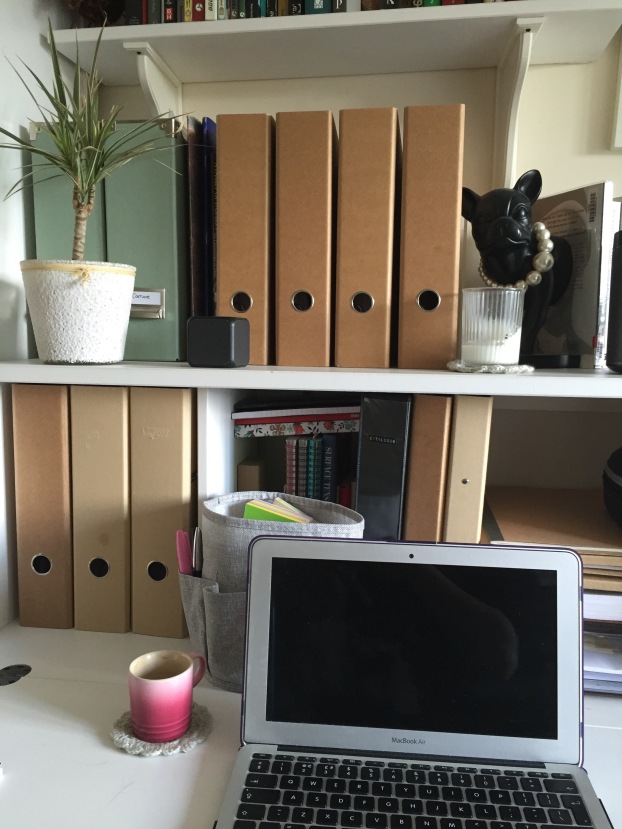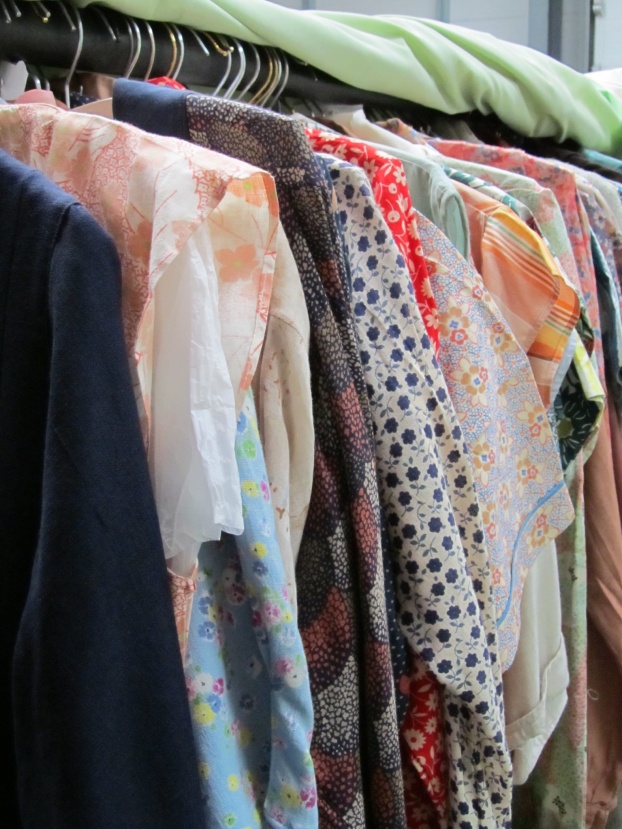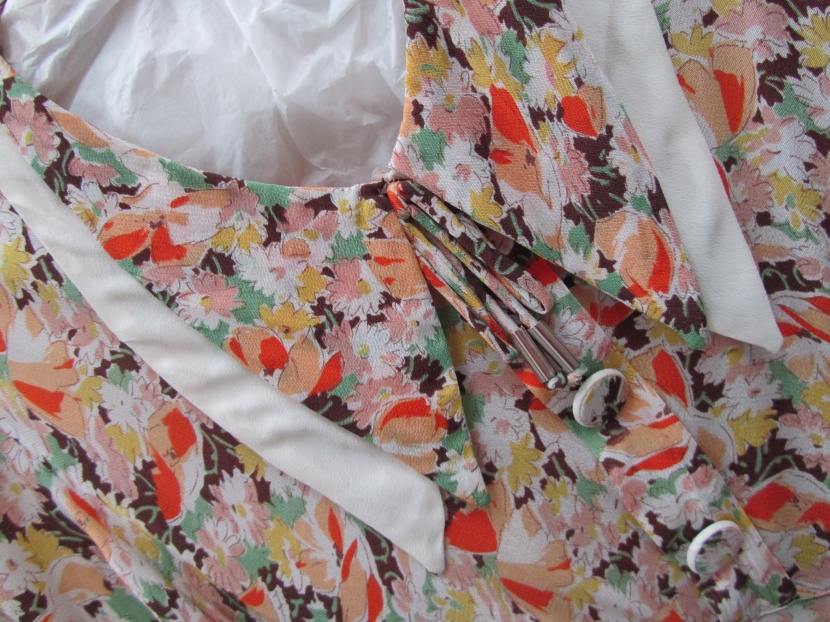Tagged: dresses
Writing Up: Some Reflections
Three years ago, three years sounded like a very long time. There were even moments, early on, when I thought I’d get this thesis done in two and spend the last year kicking back on a beach, sipping cocktails and making hilarious jokes about being a doctor of fashion (‘Diagnosis: those shoes with those trousers, seriously?’). Turns out that writing a doctoral thesis is hard and takes way longer than you’d initially expect.
I’m now officially writing up. This means that I have done all of my research and now have a year to cobble together my findings and ideas into a coherent document, one with a contents page, cover and everything. I’ve been writing since day one, way back in October 2012. I like writing and a few people told me that it was best to write from the outset of the PhD project. I’m glad I did. Sure, some of the stuff I wrote back in the early days makes me cringe and scream ‘WHAT WERE YOU THINKING?’ (e.g. I went through a proper emo poetic phase circa. Jan 2014 when I kept trying to sneak Giacomo Leopardi quotes into a chapter. Yeah, that didn’t really move anything forward and I fear my supervisor was beginning to despair but it felt really intellectual and meaningful at the time). It is satisfying to now look back through my work and observe my voice becoming clearer and stronger, my references become more elegant and my actual thesis emerge from what was once a chaotic jumble of convoluted theory and hunches.
That’s not to say the journey is over. I’ve still got a long way to go and I don’t think any academic researcher ever stands still. We are constantly learning something new, changing and developing. That’s what makes the prospect of my future career so exciting. I want to keep learning new stuff and talking to people and reading ideas and seeing things and changing things for as long as I’m on this earth (maybe that emo poetic phase isn’t quite over).
This blog has never been a place for sharing my core findings, rather somewhere to put the interesting asides or to share good or bad news. It feels right to now share something very simple that the past three years have taught me. It is something that I’d long suspected and Meryl Streep’s character in the Devil Wears Prada has eloquently expressed: clothes matter. Victoria Kelley has identified how, in the binary of surface/depth, depth is considered to hold the real value and interest. Surface often gets dismissed as somehow trivial.[1] We live in a world where interest in surface is considered a negative trait. Binaries and violent hierarchies are all well and good and I firmly believe we watch many of them play out in the world on a daily basis (ahem, Twitter). Yet I’ve come to realize that they are too neat and tidy, too black and white and way too bound up with power to be the only means by which to understand what is going on in the world around us.
My research has found that the Hodson Shop Collection has been on the subservient side of a number of binary oppositions: worn/unworn, dirty/clean, ordinary/spectacular. Yet the nature of these pairings functions differently in the museum space than in the outside world and the perceptions of the dominant/subservient relationship shifts according to who is beholding the garment or collection. A dress historian might view a dirty smudge as exciting ‘evidence’ whilst a museum visitor could consider it as off-putting. An unworn dress could be considered to lack tangible evidence of daily life for a social historian whilst it would look visually attractive on a mannequin and potentially present fewer conservation issues for a museum professional. Binaries shift and crack and that’s where the shades of grey emerge. I’ve discovered that it is these nuances that excite me.
The collection has also been subject to a host of influences beyond the surface of each garment. I’ve found that the story of the collection is one of politics, economics, emotion, gender and power. It hasn’t been a simple story of individuals determining the future lives of objects; the objects have also shaped the lives of individuals. Stuff matters and stuff can change people’s lives. The story of a dress (or, in the case of my research: 5,208 items of mass produced clothing and accessories) is entwined with that of the world and people around it. And that story doesn’t end when the dress enters the museum. Museums and museum stores are not static or sacred.
These are just a few semi-formed ideas that have been floating around in my head over the past week. Nothing earth shattering, refined or complete. The earth shattering (HA!) refined and complete stuff will happen over the course of the next few months. In the meantime, thanks for reading.
Jenxx
[1] Victoria Kelley, “A Superficial Guide to the Meaning of Surface”, in Surface Tensions: Surface, Finish and the Meaning of Objects, eds. Glenn Adamson and Victoria Kelley (Manchester: Manchester University Press, 2013), 13.
#InspirationMW and a Fond Farewell
With this being Museums Week, I’ve decided now is a good time to share one of my happiest and most inspiring memories of working with Walsall Museum. Yesterday, people were sharing their museum inspirations on Twitter using the hashtag #inspirationsmw. My museum inspiration started with a visit to Walsall Museum stores back in October 2011.
The museum will close to the public on 31st March 2015. Whilst Walsall Council’s decision to close the museum is saddening, there are reasons to remain positive about the museum’s future. There are plans afoot to move the museum to a new location in 2018 and the Changing Face of Walsall exhibition is being moved to a temporary home at Walsall Leather Museum from 25th July 2015. I’ve also been in discussion with the team regarding pop-up exhibitions. Collections will still be accessible to the public through a range of initiatives – you can find out the full details on the museum’s web page.
As a researcher, I am hopeful that the Hodson Shop Collection (and the rest of the museum’s collection) will continue to be promoted and made available for people to see and study. I’ve seen first hand how people connect with the collection. People can relate to it on a personal level – their mother or grandmother might have worn an apron like that or they had to wear a liberty bodice as a child and can remember the fabric itching on their skin. The Hodson Shop Collection isn’t about spectacle, it is about the everyday things that can often be taken for granted. The things that we don’t expect to find in a museum display but find captivating all the same. Over the two and a half years of this project, I have got to know the collection; without getting too sentimental, it is fair to say that it has found a place in my heart.
It all began back in 2011. I was preparing for my first interview for a PhD studentship and wanted to see the collection up close. I’d never visited a museum store before so I had very little idea of what to expect. I definitely didn’t expect to find myself stood outside a trading estate on the outskirts of Walsall. The building looked like any other anonymous industrial unit, with shutters and a corrugated roof. A forklift truck was buzzing around and there was a constant background clatter of light industry. The surroundings were not in keeping with the treasure trove of twentieth century clothing I had been promised.
Catherine, the museum’s Collections Officer let me in and showed me around. We didn’t know it then but we’d be working together a lot over the coming years. There are plenty of clichés and idioms about judging things by external appearances and I’m going to add another: never judge a museum’s store by it’s exterior. There were shelves stretching from floor to ceiling and aisle after aisle of treasures. The costume collection was stored on a series of calico-covered rails or in boxes stacked down the length of an aisle. Catherine pulled the cover from the Hodson Shop Collection dress rail. The dresses were arranged in age order, starting from the 1920s. I remember being struck by how colourful they were. I was allowed to take out some of the dresses to look at more closely. The first that struck me were the pastel pink and pistachio 1920s dancing dresses with the drop waist and floral corsage. My favourite was a 1930s floral tea dress with a white collar – my first response was ‘there’s something a bit Prada about it’!
There was something magical about opening the boxes and pulling away layers of tissue to reveal the contents. A box of aprons was dazzling, with a riotous mix of prints and gaudy colours. There was the blue and pink wool jersey St Margaret jumper suit, assured in its elegance and (relative) expensiveness to this day. The one thing that has stuck with me in startling clarity was the experience of opening a box of cosmetic items. The smell was overwhelming and instantly familiar – it reminded me of rummaging through my Grandma’s make up bag as a little girl and playing with her frosted pink Avon lipstick. From that point, I knew that I was hooked.
I know that I have been incredibly privileged to get this close to museum items. It is something that I am incredibly grateful to Walsall Museum for. With the closure of the museum, the Hodson Shop Collection will no longer have a display space meaning that the public won’t be able to see the garments. The prospect of the collection being mothballed and kept out of sight is awful. The Hodson Shop Collection has the potential to inspire many, many more people. It needs to be recognised and celebrated as a significant part of not only Walsall’s heritage but of British social and dress history too.
I want to take this opportunity to thank the team at Walsall Museum for their support over the past four years. They have been helpful, knowledgeable and unwavering in their commitment to this project from day one, even when times have been tough.
You can visit Walsall Museum up until Tuesday 31st March. Please show them your support!
Opening hours: Mon-Sat 10am-5pm
Address: Walsall Museum, Lichfield Street, Walsall, West Midlands WS1
Tel: 01922 653116
Current Exhibition: Red! @ Walsall Museum

From left: printed cotton day dress, c.1951 (Hodson Shop Collection), red grosgrain short evening dress with roses, c.1958.
Sometimes it is the simplest ideas that prove to be the most effective, as evidenced by Walsall Museums latest dress exhibition: Red!
As you might have figured from the title, the exhibition is a celebration the colour red, most specifically the iconic red dress.
All of the dresses have been drawn from Walsall Museum’s massive costume collection and include several items from the Hodson Shop Collection. The dresses are organised in chronological order, starting with this stunning striped muslin day dress from the 1850s (pictured below) and working their way up to this slinky satin wrap dress from the early 1990s (I love the fact that this dress is from Etam). And somewhere in the middle is this grosgrain Wishick and Webber stunner from 1958 (pictured top right).
Hodson Shop dresses include a 1920s cotton day dress with a pointed collar and daisy print, aCC41 (utility) rayon crepe dress with a belt and button details and a 1950s floral print day dress, scattered with stripes and roses (pictured top left). Even though the Hodson dressed are far from the glitziest items on display, they certainly manage to hold their own amongst the frills and flounces.
The visual impact of the colour is undeniable, whether the dress is a glitzy beaded flapper number or a simple utility dress. It is a great starting point for planning outfits for the upcoming party season!
Red! runs until 18th January 2014 at Walsall Museum, Changing Face of Walsall Gallery on the first floor of the Walsall Central Library building. Admission is free! See What’s On Walsall for more details.
The ‘Tinkerbell’ Dress and Exhibiting the Unexhibitable
Since starting this project, I’ve spent a lot of time thinking about dirt and decay. Most specifically the importance of dirt in creating a ‘biography’ for museum garments and the curatorial and conservational challenges it poses.
Here’s the deal: when the Hodson Shop Collection was first discovered, it was dirty. Years of accumulated Black Country grime had taken its toll and left garments smeared with sooty smudges. Yet the decision was made to preserve this grime where possible as it was considered an important part of the collection’s story.
In the absence of a conventional ‘story’, i.e. one that involves someone actually wearing the garments and leaving traces and imprints of wear (this could be a scent, creases or marks), such a decision makes sense. Fashion historians and costume conservators often talk of ‘sacred dirt’ – a lipstick trace here, a spot of blood there. These are marks that are integral to the story of the garment and must be kept intact.
There are some quite touching and intriguing examples of ‘sacred’ dirt within the Hodson Shop Collection. My personal favourite is the 1930s vest that features two small cat paw prints. I love the idea of a cat crawling over the piles of unsold underwear before snuggling down to sleep on a pile of knickers!
So, yes, I find dirt very interesting! But do museum audiences share my interest or do dirt and decay present insurmountable barriers for museum visitors? How can dirt and decay be presented to museum visitors? And at what point does a dirty and decayed item become unexhibitable?
This brings me on to what I have decided to call the ‘Tinkerbell’ dress (pictured above). The name comes from the fact that it is A) green and B) falling into a state of fairy-like shredded decay. It is an item that inhabits a state of limbo, being at once inside a museum but not part of the museum’s collection.
It is a beautiful pale green silk-chiffon dress from the 1920s that was found amongst the Hodson Shop stock. It has long lace-trimmed sleeves, a high lace collar and pretty scalloped pockets made from tiers of lace. I’m was initially quite surprised that the dress was from The Hodson Shop, mainly because it is silk, very bright and involves intricate detailing – such as the clusters of tiny silk wrapped balls that sit on the lace pockets. Most of the early Hodson Shop dresses are cotton or man-made fibres, fairly drab and simple. Sheila Shreeve believes that the dress may have been bought in especially for a friend or family member, thus explaining these differences.
The dress was discovered in such poor condition that it was decided not to accession it into the Hodson Shop Collection. The silk is shattered and shredding – so much so that I was terrified to move the dress to take a picture (hence the far from ideal images above – I’ll attempt to get a better one when I am next at the museum). Whilst this decay is sad, the dress is beautiful.
During her inaugural lecture at London College of Fashion, Amy de la Haye talked about exhibiting fragmentary and shattered garments, in relation to the Fashion and Fancy Dress exhibition of the Messel Family dress collection at Brighton Museum in 2005. According to de la Haye, fabric’s natural ability to ‘disintegrate with the progress of time’ reflects our own human fragility. She gave a wonderful quote from Anne Messel: ‘Their frailty is their magic, don’t you think?’
It was this thinking that lead to the inclusion of a shattered and fragmentary dress in the exhibition. It was laid flat – with its damage and decay exposed to visitors. It was ‘the unexhibitable exhibited’.
Interestingly, an image of a shattered corset worn by Maud Messel was used as the invite for de la Haye’s lecture (see below), suggesting that decayed garments can often make a lasting impression upon on those who come into contact with them.
Unlike the shattered Messel dress, the Tinkerbell dress has not been worn and it is not attached to an illustrious family of aristocratic fashion collectors. Maybe it is wear and attachment to a personality that make signs of decay palatable to museum visitors – are they what enable the unexhibitable to be exhibited?
Whilst the Tinkerbell dress is unlikely to ever be exhibited or accessioned, it has provided me with a lot to think about. I feel very lucky to have experienced this dress in all of its magic frailty.








